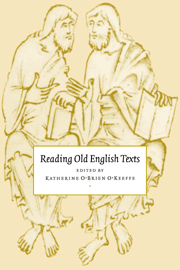Book contents
- Frontmatter
- Contents
- List of contributors
- List of abbreviations
- Note on the text
- Introduction
- 1 The comparative approach
- 2 Source study
- 3 Language matters
- 4 Historicist approaches
- 5 Oral tradition
- 6 The recovery of texts
- 7 At a crossroads: Old English and feminist criticism
- 8 Post-structuralist theories: the subject and the text
- 9 Old English and computing: a guided tour
- Suggestions for further reading
- Index
1 - The comparative approach
Published online by Cambridge University Press: 18 December 2009
- Frontmatter
- Contents
- List of contributors
- List of abbreviations
- Note on the text
- Introduction
- 1 The comparative approach
- 2 Source study
- 3 Language matters
- 4 Historicist approaches
- 5 Oral tradition
- 6 The recovery of texts
- 7 At a crossroads: Old English and feminist criticism
- 8 Post-structuralist theories: the subject and the text
- 9 Old English and computing: a guided tour
- Suggestions for further reading
- Index
Summary
The comparative approach is instinctive to human intelligence. From our very infancy we learn by comparing like with like, and by distinguishing the like from the nearly like and the other. Students of cognitive psychology describe the process as ‘discrimination learning’ (a term coined by Marvin Levine), and the term ‘analogy’ is used by psychologists to denote a partial similarity between different situations which elicits further inference, and hence understanding. Similar terminology is used by students of comparative literature, who seek to make discriminations (as in the title of a celebrated book by Rene Wellek, the doyen of American comparatists) between works of literature in different languages having partial similarities; by the same token, comparatists describe resemblances in style, structure, mood, or idea between works which have no other connection as ‘analogies’. By studying analogies and learning to make discriminations between partially similar works in different languages, comparatists may be said to replicate an important aspect of human learning. Because of its instinctive nature, the comparative approach is accessible to any student of literature who is versed in at least two languages, and in the case of Old English has been practised by critics of very various ability, since the time when Old English literature first emerged as a subject of interest in its own right. In what follows, I shall attempt to trace the course of comparative analysis from the early nineteenth century onwards, in order to illustrate the presuppositions under which comparative analysis has been attempted, and also to indicate areas where this most accessible of critical methods may yet yield interesting results.
- Type
- Chapter
- Information
- Reading Old English Texts , pp. 20 - 38Publisher: Cambridge University PressPrint publication year: 1997

